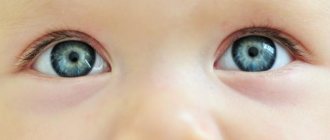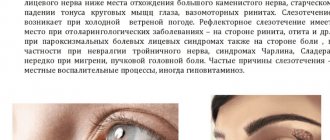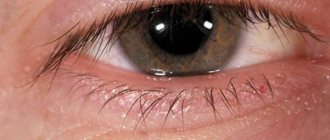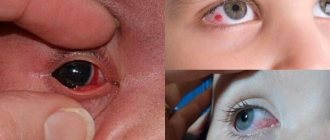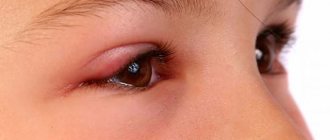If a blood vessel bursts in a child’s eye, parents must act quickly and know exactly what to do: identify the cause of the red spot, apply drops to the eye, or undergo hospitalization if necessary. Usually, it is enough just to eliminate the factor that provoked the hemorrhage in the orbit, and not a trace will remain of the burst vessel. Capillaries can burst in infants who are not even a month old, and in children one year old, especially when they actively begin to walk and receive various injuries. It is necessary to provide timely assistance so as not to deprive the baby of his vision in the future.
A blood vessel burst in my eyes
Causes of a burst vessel in newborns
When a capillary in a child’s eye bursts, there are a large number of circumstances:
- Consequences of childbirth. When a child begins to pass through the birth canal, his head is subject to strong external influences and compression. According to statistics, every fifth baby is born with blood vessels that can burst during birth.
Important! Inducing labor is not the best solution to the desire to give birth faster. It is known that in about 50% of babies, when the birth process is “accelerated,” the capillaries burst, and the situation can also be complicated by pathology.
- The vessels are very fragile. This explains why vascular injury occurs when a baby coughs or sneezes.
- In case of mechanical injury, when the baby gets a finger, toy or other foreign object on the mucous membrane of the eye. In such cases, the eye socket will be very painful, causing discomfort for the baby.
- Various diseases: flu, sore throat, viruses, eye infections. They are also accompanied by an increase in temperature.
Conjunctivitis in a child
- Pressure changes due to weather changes.
- Metabolic disorders, diabetes mellitus, hypovitaminosis. The blood vessels become thinner and often rupture.
- Deficiency of vitamins A, C and E in the body.
- Too much time is spent on tablets and gadgets.
- Dry air, strong wind or bright light cause a child to rub his eyes, which can damage the capillaries.
Why red capillaries appeared in the eyes of an adult: reasons
Redness does not yet indicate that the blood vessels have actually burst. Most often, the appearance of severe redness is caused by head injuries, high blood pressure, and infectious eye diseases. Significant trauma is required for the vessels to burst. Most often, redness is caused by inflammation.
Possible causes of red capillaries:
- Blepharitis. This is a disease that can be caused by both viruses and bacteria, fungi that affect the eyelids
- Conjunctivitis. During this disease, the membrane of the eye becomes inflamed, and therefore the thin capillaries that nourish the eye become red and inflamed.
- Mechanical damage. This happens when foreign bodies get into the white of the eye. It is observed among factory workers whose work involves working in hazardous conditions with coal dust or metal shavings. Even the smallest piece of chips can get into the eye and significantly injure it.
- Constant strain on the visual organs. Happens when a person spends most of the time at a computer, works with a microscope, or is associated with constant attention and eye work
If red capillaries in the eyes are caused by infectious or viral diseases, then other symptoms also occur. This is increased lacrimation, itching in the eyes, eyelids, and discharge from the tear ducts may also be observed. This indicates that it is necessary to urgently contact an ophthalmologist, who will prescribe further treatment after the examination.
Red capillaries on the eyes
Eye diseases are very common in children after suffering from acute respiratory viral infections. Because bacteria from the nasal passages penetrate the eyes, causing bacterial as well as viral conjunctivitis. Therefore, if your child has recently been ill, consult a doctor if you notice redness or itching in the eyes. The fact is that in most cases, bacterial conjunctivitis is transmitted. This is an infectious disease, so family members need to be careful, provide a separate towel for the child and wash the eyes, as well as carry out the treatment prescribed by the doctor.
Types of hemorrhages
The child does not eat porridge - possible reasons for refusal
Depending on where the vessel burst in the newborn’s eye, the following forms of hemorrhage are distinguished:
- In the retina - this is the most common type among infants.
- In the eye socket. Such hemorrhages appear during injuries and contusions, while the eyeball seems to “protrude” forward. A hematoma may form.
- Into the vitreous body. A tubercle forms on the sclera due to burst retinal vessels. At this moment, vision decreases.
- In the anterior chamber. Blood appears between the iris and cornea of the eye. The condition can last up to 10 days. A doctor's examination is required.
Hemorrhage into the anterior chamber
The blood vessels in the eyes turn red: what to do?
If you spend a lot of time in front of a computer screen, then red eyes are not surprising. At night, when there is insufficient lighting, capillaries can actually burst. To reduce eye strain, be sure to use glasses with a special polarized coating that protects your vision from overstrain. You can use drops such as Artificial tears. This will prevent the mucous membrane of the eye from drying out and recovering. Homeopathic drops Okulohel help well, they actively relieve fatigue, as well as minor eye damage.
If your eyes are red as a result of conjunctivitis, you need to find out the cause of the disease. If it is a virus, antiviral drugs are taken. There are drops that contain human Interferon that can be used in the eyes. This will stimulate local immunity. In case of bacterial conjunctivitis, antibiotics are prescribed. Drops such as Levomycetin are suitable for this; ointments containing antibiotics are also prescribed.
The blood vessels in the eyes turn red
For blepharitis, antiviral and antibacterial drugs are also prescribed, depending on the causative agent of the disease. As for redness after eye injury from dust, pieces of glass or metal, or coal, you must urgently contact a medical center, as well as an ophthalmology center. The doctor will be able to remove pieces of foreign objects and prescribe a remedy that will prevent the occurrence of infection. Very often it takes time for the eyes to recover, so patients may be given sick leave.
We do not recommend treating conjunctivitis, blepharitis and other inflammatory eye diseases; treat them yourself. Because the symptoms may be similar, but the pathogens are completely different. Accordingly, antibacterial therapy will not give any results. If you are infected with a virus, you will only cause harm and may contribute to the occurrence of a fungal infection, which very often appears after bacterial eye infections.
Redness
Associated symptoms
When a capillary bursts in a baby's eye, it is immediately visible. A small red spot or streak may appear immediately after birth, but usually disappear soon. Aesthetically, a blood-filled vessel immediately stands out, and blue-red circles may be visible under the eyes.
The child has feces like plasticine - possible causes
If a child has a hemorrhage in the eye, he begins to complain of discomfort, pain, soreness of the eyelids and simply fatigue, rub his eyes, be capricious, and get irritated.
Note! If a capillary bursts due to increased pressure, then the baby will also indicate a severe headache. It will be weak, sweating may increase, and the temperature will rise.
Usually the hemorrhage occurs in more than two eye sockets. This only happens immediately after birth. If the newborn period has already passed, and both eyelids have become red, you should immediately seek medical help.
Causes
If a baby has a red or pink spot in his eye, this may be the result of injury, illness, or crying.
Why a blood vessel in the eye may burst:
- Infection. Viruses affect not only the mucous membranes of the nasopharynx, but also the conjunctiva. Inflammation can cause destruction of capillaries and bleeding into the eye.
- Colds. With a hysterical cough, sneezing and runny nose, the pressure on the blood vessels can be excessive and they burst. High temperature also provokes bleeding.
- Severe or prolonged crying. The longer the baby does not calm down, the higher the likelihood of capillary damage.
- Foreign body. While playing, children can bring particles of dirt onto the delicate cornea. When experiencing discomfort, they rub their eyes with their hands, which causes mechanical damage to the thin walls of the blood vessels.
- Constipation. By pushing hard, the child causes excessive pressure on the capillaries.
- Injury.
- Fragile vessels by nature.
- High blood pressure.
- Great strain on the eyes. If a child spends a lot of time reading, watching TV, using a computer, using a smartphone, or wearing unsuitable glasses, the capillary may burst. The same problem can arise if hygiene and rules for wearing contact lenses are not observed.
- Intraocular pressure. Only an ophthalmologist can determine its deviation from the norm. Parents should consult a specialist if, in combination with a damaged vessel, the child complains of a headache, lacrimation, or a sensation of a foreign body in the eyes.
If, apart from a reddish spot in the eye, the child does not experience any other symptoms different from the norm, you need to conduct an examination with clean hands. If a foreign body is found, carefully remove it and rinse your eyes.
How to treat
To prevent unpleasant consequences, you should accurately identify the cause of the burst vessel and then provide the necessary assistance.
First aid
Monocytes are elevated in a child under one year old - possible reasons
If your child has been sitting on a gadget for a long time, then you should provide him with proper rest and not give him the tablet for several days, limit watching TV for at least 2 days. During this time, the protein should become white again. It is permissible to drip only those medications that moisturize the mucous membrane.
Additional Information. If the eye is injured, apply a sterile bandage and ice. The compress is removed after 2 hours. This way you can significantly narrow the capillaries, remove swelling and reduce bleeding.
If an eyelash or sand gets into the eyelid, the eyes are washed with clean boiled water. You can add chamomile or string herbs to the solution, which have anti-inflammatory and antiseptic effects.
Nuances of therapy for newborns
If a capillary bursts in a newborn, then no measures are needed. Everything goes away without intervention in 2-4 days.
What not to do
If you behave incorrectly, you can greatly aggravate the situation.
What not to do:
- Rubbing your eyelids with your hands can further develop the infection and cause complications.
- Trying to “hide” the defect with various cosmetics.
Don't rub your eyes - this will make the situation worse.
- Rinse your eyes with tea solution. This not only will not remove inflammation, but can also cause conjunctivitis.
- If the capillaries burst constantly, then no self-medication can be carried out. You should immediately contact an ophthalmologist, as he can detect the development of any disease.
- Buy and select medications or antibiotics yourself.
- Touching your eyelids with dirty hands will cause an infection.
Causes and treatment of vascular fragility due to vasculitis in children
The exact causes of the primary pathology have not been established. Provoking factors include autoimmune diseases, chronic infections, allergies to medications, overheating and hypothermia. The disease may be associated with vaccination, since in some cases the administration of the vaccine causes negative reactions from the vascular system. Sometimes vasculitis occurs on its own, without any prerequisites.
Typical signs of vasculitis:
- Fatigue, fainting;
- Migraine;
- Vomit;
- Decreased vision;
- Loss of sensation in limbs;
- Hard breathing.
Inflammation spreads to the joints due to damage to the arteries. Treatment in this case is characterized by a comprehensive approach and duration. Therapy is carried out exclusively in a hospital setting.
Medicines are selected taking into account the goals of treatment:
- stop the stage of the disease, prevent complications;
- eliminate the risk of death in severe cases;
- relieve symptoms;
- prevent consequences.
The main cure for fragility of blood vessels in this case is glucocorticoid drugs. Cytostatics and indomethacin are also used. Medications may be prescribed to dilate blood vessels and support elasticity.
Advice from pediatrician Komarovsky
Dr. Komarovsky, a famous Russian pediatrician, notes that the health of a baby in 80% of cases depends on the sanity of the parents. They are obliged to provide basic prevention of capillary hemorrhages and ensure that the baby does not cause dangerous injuries to himself.
Prevention is simple:
- strengthen the body's protective functions;
- exercise caution;
- provide safe living conditions for the baby.
If a child abuses sweets, leads a sedentary lifestyle and does not walk in the fresh air, already in childhood he will worsen the condition of blood vessels. Healthy eating and walking are the key to success and health.
You should also protect your child's eyes from direct sunlight. In order for the blood vessels to be strong, the child must get enough sleep, especially at an older age, so it is important to establish a daily routine.
Diagnosis and treatment
To check the clarity of vision and search for the reasons for its deterioration, a number of examinations are carried out: measurement of intraocular pressure, ultrasound of the eye structure, determination of visual acuity and field, etc.
If a blood vessel suddenly bursts in a child’s eye, you should, without panicking, ask the child what happened. You cannot try to remove a foreign body (scale, sand, any foreign body) yourself. You need to put a bandage on your eye and go to the hospital.
Doctor examining a child's eye
If a vessel in a child’s eye bursts, the doctor determines the cause of the incident and carries out appropriate therapeutic actions:
- removes foreign bodies from the eye, cleanses, rinses the mucous membrane from debris and dust;
- when dry eye syndrome is established, prescribes eye drops to moisturize it;
- To strengthen the walls of the eye vessels and increase their elasticity, he recommends special solutions
- prescribes medications with vitamins (Rutin, Ascorbic acid, Blueberry forte) to strengthen fragile blood vessels;
On the recommendation of an ophthalmologist, you can do rinses, eye baths, and instillation of prescribed eye drops at home, strictly observing sterility, rules and doses.
You can wash your child’s eyes only after the recommendation of an ophthalmologist.
It should be remembered that many eye medications have side effects and should not be used on young children. Eye drops approved for babies and even infants are: Ophthalmodek, Tobrex, Floxal can be used. Taufon is not recommended for people under 18 years of age.
If redness of the whites of the eyes is accompanied by a cold, high fever, or conjunctivitis, you need to focus on treating the underlying disease. In this case, vitamins:
- C (rosehip decoction, tea with lemon);
- A – blueberries, dried apricots, carrots;
- E (sea fish)
will be a good support for the body and eyes during the treatment of an infectious or cold disease.
It is important to maintain children's drinking regime. It is necessary to give more liquid to children so that the blood vessels do not burst from a lack of moisture and dry protein.
After therapeutic measures, restorative procedures may be prescribed to eliminate the consequences.
- When working on a computer, create comfortable lighting and maintain an optimal distance from the monitor. Make sure children do not sit too close to the screen. Take a break every hour. Children are not allowed to sit for a long time in front of a monitor or TV screen (norm: 20-30 minutes/day for children 12-16 years old);
- carry out eye exercises to strengthen muscles and blood vessels, relieve eye fatigue;
- take vitamins to strengthen blood vessels and foods rich in vitamins A, C, E;
- do not give children strong tea and coffee;
- Give young children enough fluids;
- normalize rest (sleep) mode;
- tell children how important it is to protect their eyesight and instruct them how to avoid injury;
- Avoid stressful situations, loud screaming, especially when communicating with a child.
If small particles get into your child's eyes, you can rinse them with a decoction of warm tea or chamomile. And if a vessel bursts, instill Oftalmodek or Torbex to prevent infection.
In this article we will look in detail at what to do if a vessel in a child’s eye bursts, and what are the reasons for what happened?
Children, due to their age, often cannot explain what bothers them. An attentive parent will be able to determine by external signs and behavior that the child is currently feeling unwell and consult a doctor in time.
Fragile capillaries
If a vessel in a child’s eye bursts, this can be noticed not only visually, but also by behavior:
- The baby is restless, constantly rubbing his eyes, so they are accompanied by a burning sensation and a feeling as if sand had gotten into them.
- If the vessel has been destroyed as a result of increased intracranial pressure or severe headache, then you may notice that the baby feels unwell, cold sweat, and weakness.
- When blood is released from the affected artery and the space in the eye is filled, this is already visible to the naked eye.
- Broken blood vessels around the eyes appear as dark circles under the lower eyelid.
Photo characterizing signs of discomfort in the eye
There is no need to panic, you just need to understand the reasons that affected the integrity of the vessel; perhaps there is nothing wrong. But in any case, you should go to the clinic, where the doctor will find the cause and determine whether what is happening is affecting vision.
Before going to the hospital, you should take a sober look at what is happening and think about what could have such a negative effect on the eye.
Bursted blood vessels in a baby’s eye can indicate various reasons, depending on age, and are not always dangerous.
- Severe overexertion in infants. If a vessel ruptures in the eye of an infant, the cause may be long and strong crying, after which a red mark forms in the eye. It’s not scary, it’s just that there was a strong load on the baby’s delicate capillaries.
The baby is crying
Types of hemorrhages
As a result of the type of bleeding that occurs, the doctor can determine whether the fragility of the visual vessels poses a risk.
Table - Types of ocular hemorrhage:
In the retina of the eye
In the eye socket itself
In the vitreous
In the anterior chamber of the eye
When to see a doctor urgently
The following situations require an immediate visit to the doctor:
- The hemorrhage does not go away, swelling and suppuration have appeared. Perhaps the baby is diagnosed with an infection.
Adenoviral eye infection
- If a foreign body gets into the eye socket.
- If the child is very lethargic or, conversely, too capricious.
- The baby complains of pain in the eyes and headache.
The doctor removes the mechanical irritant (dust or foreign body), diagnoses the presence of infection and, if necessary, prescribes drug therapy or suggests going to a hospital for treatment.
Medicines that an ophthalmologist may prescribe:
- Drops to reduce pressure in the eyes;
- Local solutions to strengthen the eye capillaries;
- Vitamin products.
Thanks to the eyes, a person perceives the surrounding world as bright, and capillaries play an important role in this process. If for some reason the baby’s blood vessels are damaged or burst, you should pay attention to this and promptly seek help from a doctor.
Fragility of blood vessels: vasculitis in children
Symptoms may vary from case to case and largely depend on the provoking factor.
Headache, weakness, and increased body temperature may occur. For example, when the pathology is provoked by heatstroke, then nausea, vomiting, dizziness and chills are always present. The disease first appears as small red dots, which later turn into ulcers.
First, the walls of blood vessels are affected, then organs and joints.
First of all, blood circulation in the arms and legs is disrupted due to poor blood flow into the arteries. As it progresses, all organs and systems suffer due to the lack of normal blood circulation. Prolonged course can lead to tissue necrosis.


